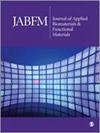以非取代咪唑基离子液体为聚合介质制备纳米聚苯胺,使超级电容器运行速度更快
IF 3.1
4区 医学
Q2 BIOPHYSICS
Journal of Applied Biomaterials & Functional Materials
Pub Date : 2022-09-30
DOI:10.35745/afm2022v02.03.0001
引用次数: 0
摘要
研究了非取代咪唑基质子离子液体,即咪唑硫酸氢[Imi][HSO4]作为聚苯胺(简称PANI/PIL)的聚合介质。然后研究了所得材料作为超级电容器的电极材料。通过一步酸碱反应制备了[Imi][HSO4],并通过1H NMR对其结构进行了证实。[Imi][HSO4]由于其离子的电荷密度分布,与水表现出完全的混溶性。此外,[Imi][HSO4]/水二元混合物呈强酸性(如[Imi][HSO4]/水在70/30的质量比下pH ~ 0.1)。[Imi][HSO4]作为聚苯胺/PIL的聚合介质,起到软模板剂的作用,在不影响聚苯胺典型结构的情况下,诱导形成具有纤维状形态的纳米结构聚苯胺(如SEM图像所示)(经FT-IR分析证实)。此外,聚苯胺/太平盐以翡翠盐的形式得到,没有任何不良的副产物。此外,用四探针法测定的电导率(~ 21.8 S/cm)比传统聚苯胺(即聚苯胺/盐酸)高7倍。PANI/PIL的电导率和纤维状形态的改善对其电化学性能产生了积极的影响,并突出了[Imi][HSO4]作为PANI材料聚合介质的适用性。本文章由计算机程序翻译,如有差异,请以英文原文为准。
Nanostructuring Polyaniline Using Non-Substituted Imidazolium-Based Ionic liquid as Polymerization Medium Enabling Faster Supercapacitor Operation
Non-substituted imidazolium-based protic ionic liquid, namely imidazolium hydrogen sulfate [Imi][HSO4], has been investigated as a polymerization medium for PANI (designated as PANI/PIL). The resulting material was then investigated as electrode materials for supercapacitors. [Imi][HSO4] was prepared via a one-step acid-base reaction, and its structure was confirmed by 1H NMR. [Imi][HSO4] displayed full miscibility with water owing to the charge density distribution of its ions. Furthermore, the binary mixture [Imi][HSO4]/water is highly acid (e.g. pH ~ 0.1 for [Imi][HSO4]/water in a weight ratio of 70/30). As the polymerization medium for PANI/PIL, [Imi][HSO4] plays the role of a soft template agent and induces nanostructured PANI formation with fibrillar morphology (as shown by SEM images) without affecting the typical structure of PANI (as confirmed by FT-IR analysis). Furthermore, PANI/PIL was obtained in emeraldine salt form without any undesirable byproduct. Moreover, the electrical conductivity was seven times superior to that of the conventional PANI (i.e. PANI/HCl) when measured by the four-probe technique of PANI/PIL (~ 21.8 S/cm). This improvement in the PANI/PIL’s electrical conductivity of as well as the fibrillar morphology of PANI/PIL positively influences its electrochemical performances and highlights the suitability of [Imi][HSO4] as a polymerization medium for PANI material.
求助全文
通过发布文献求助,成功后即可免费获取论文全文。
去求助
来源期刊

Journal of Applied Biomaterials & Functional Materials
BIOPHYSICS-ENGINEERING, BIOMEDICAL
CiteScore
4.40
自引率
4.00%
发文量
36
审稿时长
>12 weeks
期刊介绍:
The Journal of Applied Biomaterials & Functional Materials (JABFM) is an open access, peer-reviewed, international journal considering the publication of original contributions, reviews and editorials dealing with clinical and laboratory investigations in the fast growing field of biomaterial sciences and functional materials.
The areas covered by the journal will include:
• Biomaterials / Materials for biomedical applications
• Functional materials
• Hybrid and composite materials
• Soft materials
• Hydrogels
• Nanomaterials
• Gene delivery
• Nonodevices
• Metamaterials
• Active coatings
• Surface functionalization
• Tissue engineering
• Cell delivery/cell encapsulation systems
• 3D printing materials
• Material characterization
• Biomechanics
 求助内容:
求助内容: 应助结果提醒方式:
应助结果提醒方式:


